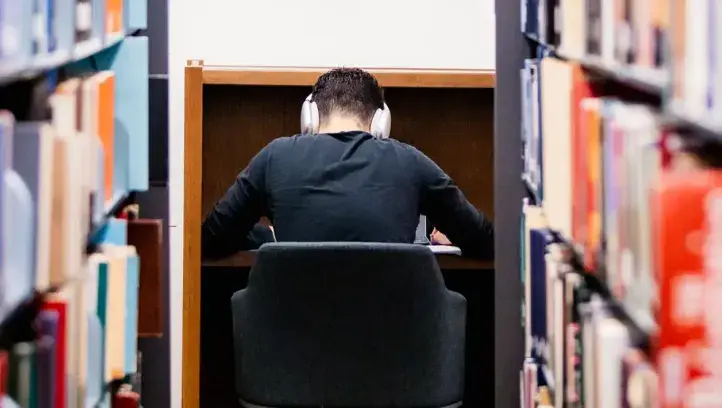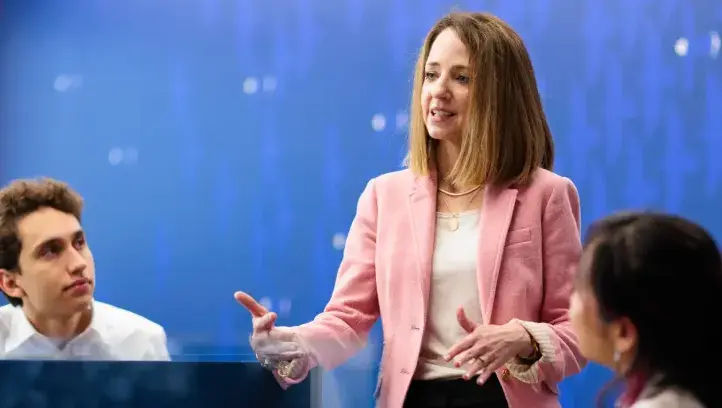
Researching a safer battery for space travel

The National Aeronautics and Space Administration (NASA) explores the unknown in air and space, but much of space remains just that: unknown. Can we go farther out there? And stay longer?
The questions arise from NASA’s Science Mission Directorate, a division of the agency that “seeks to protect and improve life on Earth and space.” But to boldly go where we have never gone before requires a safer, more compact, more reliable electric power source not available — yet. To find some answers to the questions, the Science Mission Directorate connects researchers and resources across the nation’s science community to support the development of Earth and space science-related technologies.

“NASA is actively interested in researching alternative batteries for aviation technology,” says Angela Devlin, PhD, assistant professor of chemistry. Devlin is exploring a possible alternative while including undergraduate students in the research. Her work, funded by a NASA Nebraska EPSCoR Grant, explores the use of a novel type of solid-state electrolyte for an energy-dense battery — one that is not the popular, but precarious, lithium-ion battery.
The lithium-ion battery is the “workhorse battery technology,” says Devlin. These batteries are part of everyday lives — powering mobile phones, electric cars, laptop computers and devices on the International Space Station. “But they pose some safety risks given that there’s flammable liquid inside the battery,” Devlin says.
Lithium-ion batteries contain electrolytes in liquid form coupled with significant stored energy. Any abuses to that system — short circuits or exposure to elevated temperatures — can cause an explosive chain reaction known as a thermal runaway.
“This is a phenomenon that has plagued the lithium-ion battery industry since the beginning,” says Eric Darcy, battery technical discipline lead at NASA’s Johnson Space Center, on the “Better Batteries” episode of Houston We Have a Podcast.
Of all the cells produced by a battery manufacturer, the risk is about 1 in a million to 1 in 5 million of a catastrophic defect, he explains.
“Well, when you’re dealing with laptops and you’re dealing with small batteries, it’s something that you can deal with,” says Darcy. “But once you start being in a confined space of a spacecraft with a battery that has many, many cells, thousands of cells, you can’t use that approach anymore.”
Devlin, who has a special interest in materials chemistry, is considering a more stable electrolyte in a battery.
“The idea is that if we take away the volatile liquid part of the battery and replace it with something solid, you don’t have the flammability issues associated with the electrolyte within a lithium-ion battery.”
Any sort of failure in the material can be disastrous in a spacecraft mission, or in the technology grounded on Earth.
“As electric cars are becoming more popular, electric everything is becoming more in demand,” says Devlin. “That large-scale lithium-ion battery could pose an even greater risk for the types of energy stresses that our world is demanding.”
A solid-state electrolyte in a battery could mitigate the safety issues. The hypothesis is being tested at Creighton, where Devlin and three students conduct experiments with different metal-organic frameworks, which are highly porous crystalline materials, to test chemical interactions that translate into enhanced conductivity. If the hypothesis proves successful, it could lead to the next generation of better batteries.
“The research lab is a new kind of learning. It’s messy, it’s not always a linear process. We make hypotheses and they might be wrong, or the experiment may fail. And it can be frustrating, sure,” says Devlin, “but I like to think of it as good failure training. ‘What can we learn from it?’”
The NASA battery subject caught the curiosity of Emma Fredstrom, a Spanish and Hispanic studies major, to participate in Devlin’s research. “It is just something so unique that I had never heard of before,” says Fredstrom, who is looking to make a deeper impact on an undergraduate research project by picking one to put her time and efforts behind. “I will be able to learn about all parts of the research process, and gain critical thinking and collaborative skills, while contributing to the outcome of the project.”
All skills that Fredstrom says she hopes to apply in her future. Her career aspirations include medicine and research and using her Spanish language skills to serve underserved communities.
Devlin values the mentorship relationship within undergraduate research. “I like to work directly with students, and my hope is that students I train can ultimately feel confident in their skills in the lab. And I think it’s also a good opportunity for students to see that their professors are also still learning. I have research questions, and I don’t necessarily know the answers,” says Devlin. “So, certainly, a lot of work still needs to be done, but it’s an area that is worth exploring.
“Battery usage affects all of us.”




